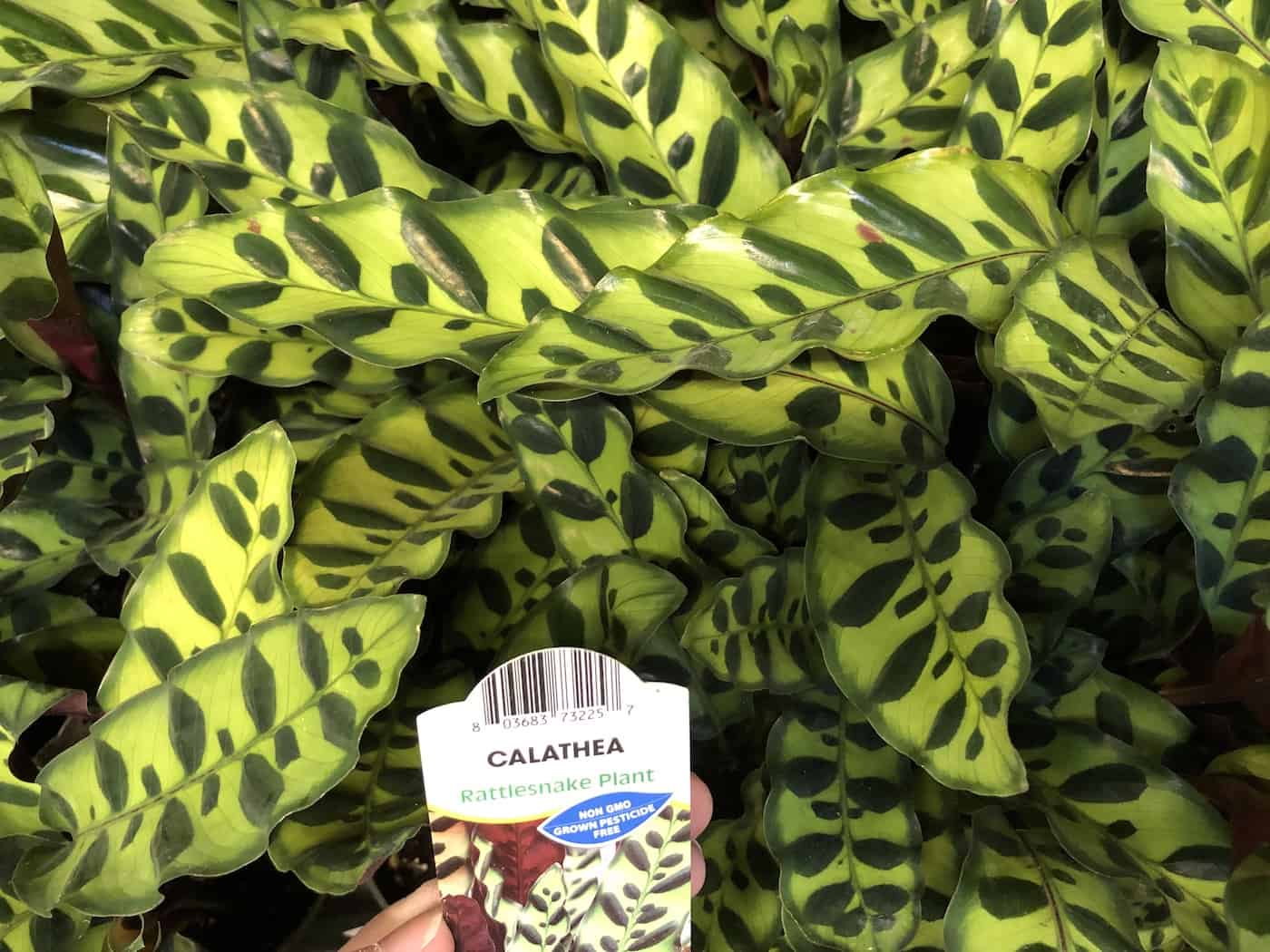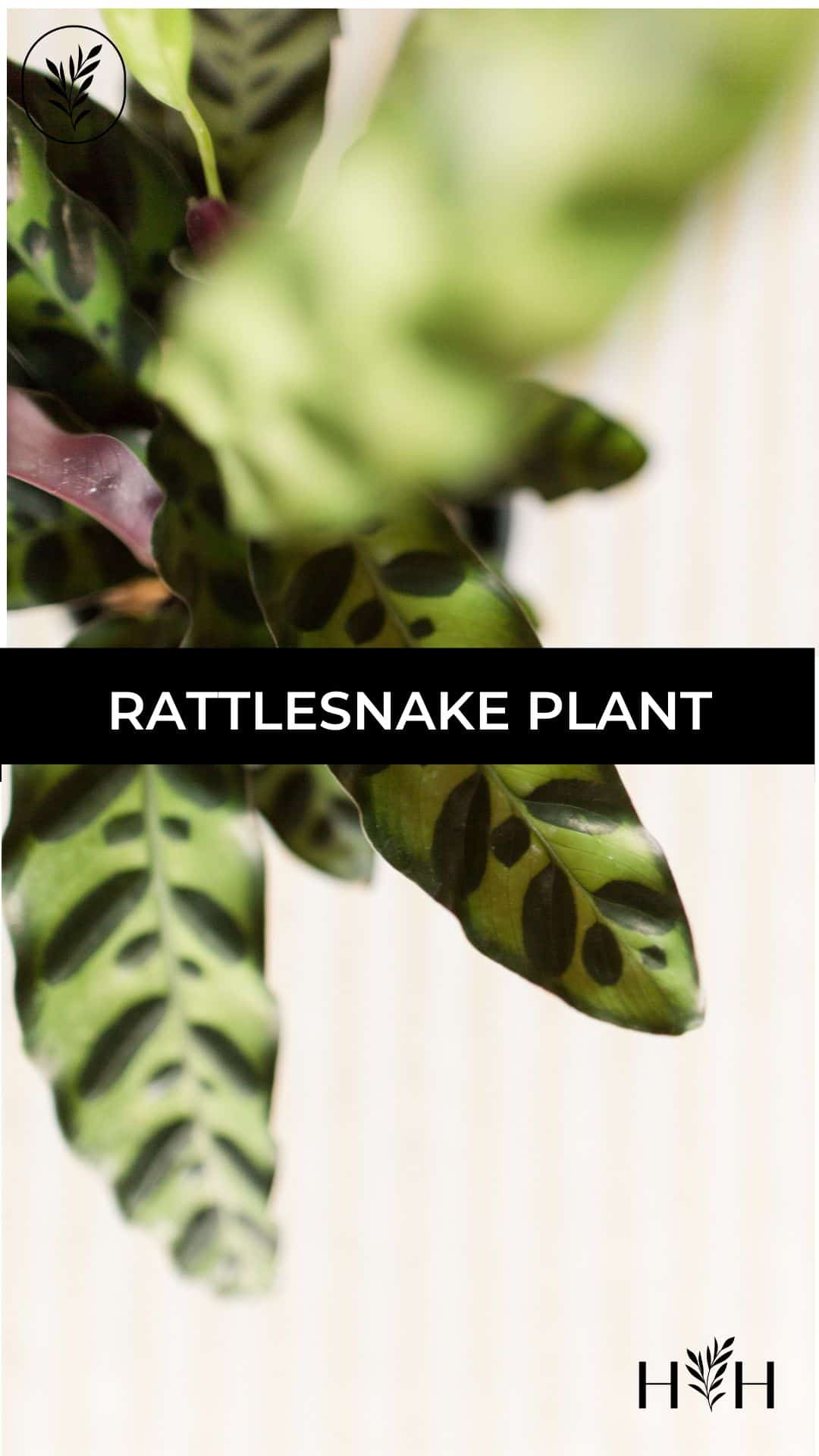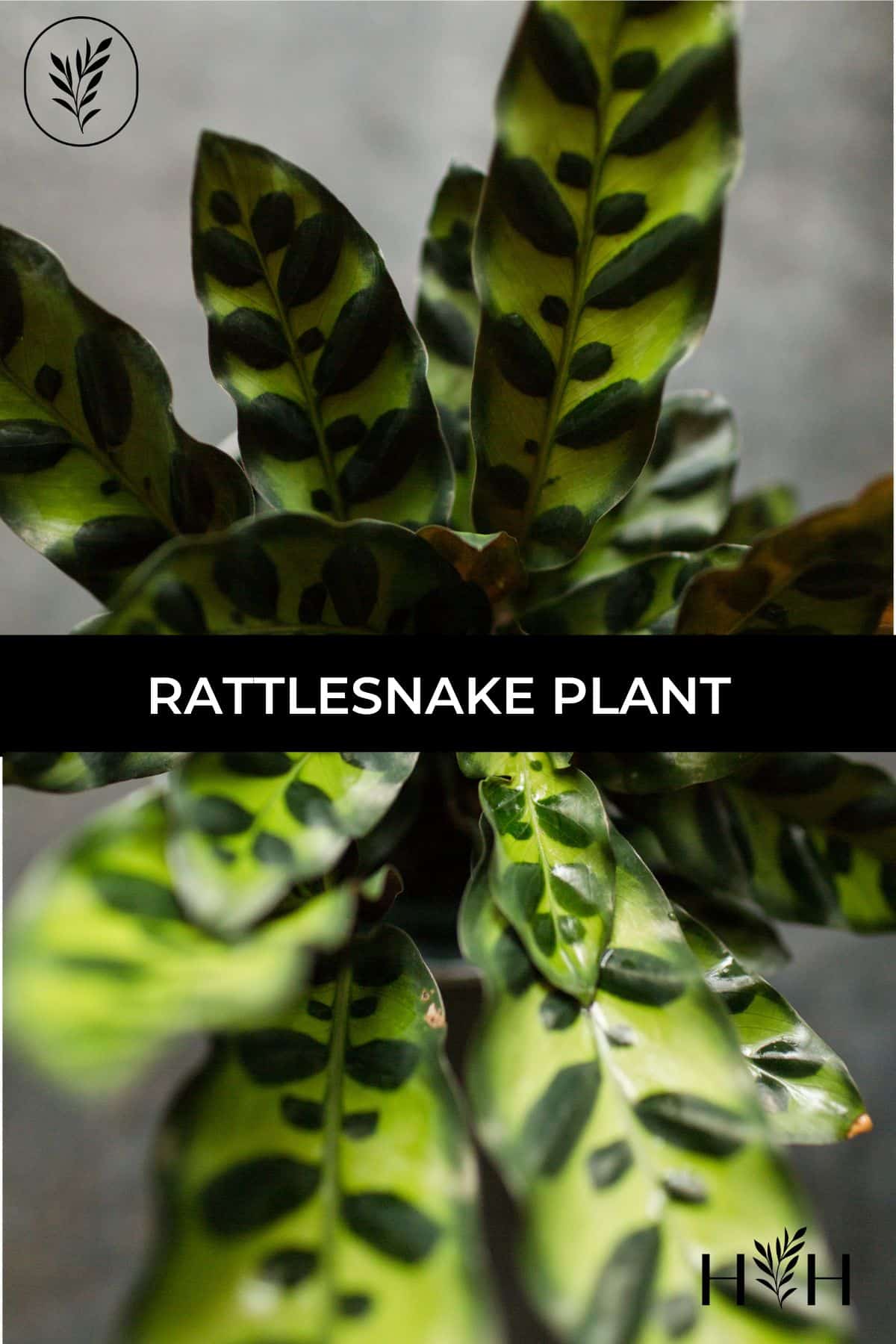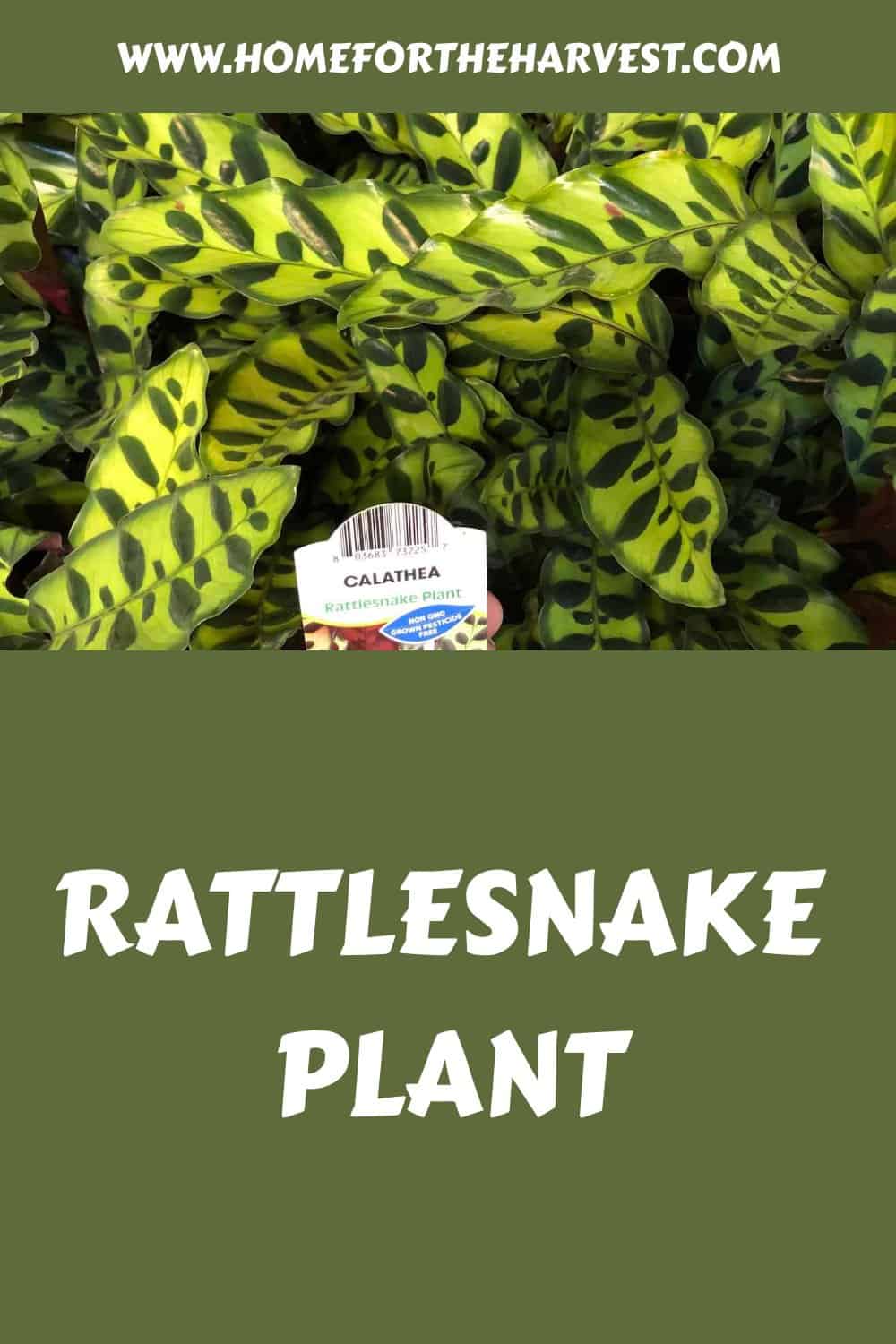For those who love contrast, color, pattern, and texture in houseplants, the rattlesnake plant truly has it all. Although these leafy beauties can be slightly tricky to keep alive, they are well worth the extra effort.
Rattlesnake plant requires consistently moist but not waterlogged potting soil to grow successfully. Rattlesnake plants can handle moderate light but prefer areas with bright indirect light away from full sun.
High temperature and humidity, along with a regular fertilizing routine, will keep a rattlesnake plant looking its best year-round. Don’t forget to wipe down the long leaves frequently to remove any dust and keep them glossy.
Consistent plant care is important for the longevity and healthiness of light and dark green plants. A rattlesnake plant will make a wonderful indoor plant and a beautiful addition to any home!

Rattlesnake plant basics
The rattlesnake plant was previously classified as part of the Calathea genus. This relation is clear in the long leaves that feature interesting and colorful patterns like other members of the genus. However, the genus was later changed, leading to the current scientific name Goeppertia insignis.
You may still find these plants labeled Calathea lancifolia in nurseries, or by the other common name rattlesnake calathea, but stick to Goeppertia insignis if you want the current botanical Latin species name.
This species is part of the Marantaceae family, otherwise known as a prayer plant. The namesake of a prayer plant is based on the leaves opening and closing like hands in prayer.
Some other varieties of the Rattlesnake plant include the Goeppertia makoyana, otherwise known as the peacock plant, and the Goeppertia zebrina, commonly known as the Zebra plant. The Zebra plants in particular are easy to identify, as they have distinct oval-shaped light green leaves with dark green stripes.
In their native habitats, Rattlesnake Plant does produce yellow blooms in late spring that stand out among the light green and purple foliage.
But when growing indoors and in unfavorable conditions, you’re unlikely to see these yellow flowers pop up, allowing you to appreciate them solely for their stunning foliage.
This tropical plant is native to South America, concentrated around Brazil. While this makes them tricky to grow outdoors in most climates, it does make them ideal candidates for growing indoors.
You can find the seeds for these plants at a garden center or grocer. They appreciate the same temperature and relative humidity as we generally find indoors and don’t mind a little shade with sheer curtains throughout the day.
Rattlesnake Plants are not the easiest houseplants to maintain. They can be fussy and require some upkeep to look their best. But with some knowledge of their needs, they won’t be any trouble for beginners or experienced plant care parents.
Sunlight requirements for rattlesnake plants
A Rattlesnake plant is found in forests in their native habitat, growing under the shade of trees. Here, they are accustomed to receiving dappled sunlight streaming through the leaves of the canopy above.
Indoors, the closest thing we have to match these native conditions is bright indirect light. This is light very close to open windows but out of the path of the direct sun.
In these areas, a Rattlesnake plant can absorb enough direct sunlight to grow its best without facing any damage from the direct sun’s rays. The thin leaves of this houseplant are quite sensitive to burning. This is important to note for proper plant care.
When left in the path of harsh direct sun in the middle of the day or in the afternoon, they will develop brown patches and crispy edging that ruins the patterned, dark green look of the foliage. Some morning sun in front of an east-facing window is usually manageable but shouldn’t be much stronger to protect the leaves.
They can also handle slightly lower light levels. Moderate light, usually in bright rooms but further away from the light source, will keep the leaves looking lush, albeit with slightly slower growth.
If you want to maintain their lush leaf color and reduce the chance of yellow leaves appearing, keep the leaves upright and remember that strong, low light is not suitable for these plants.
Watering rattlesnake plants in pots
Watering a rattlesnake plant is the task that trips up most new gardeners, leading to their ‘fussy’ label. That’s because these indoor plants need a moist, well-draining soil type during the peak growing season to maintain growth, but are also incredibly sensitive to overwatering and can’t stand soggy soil.
Due to their need for moisture and sensitivity to overwatering, avoid watering on a strict schedule (for example, once per week). This ignores environmental factors such as temperature that can impact moisture levels in the soil, quickly leading to under or overwatering.
Instead, develop a habit of testing the soil with your finger every day or two. When the top layer of soil is just starting to dry out, you can add water again. If it is still wet, wait another day or two before checking again. Keep changes in conditions in mind, checking more often in the peak of summer to stop the soil from drying out completely.
Dry soil is especially bad for these plants since they attract pests such as spider mites. However, an infestation of spider mites can be easily resolved through a gentle insecticidal soap, rubbing alcohol spray, or neem oil wash.
One way to limit your chances of overwatering is to improve drainage. This involves planting in a pot with plenty of drainage holes and repotting into a very light and well-draining potting mix.
Don’t let the pot sit in water in a pot cover or drip tray – always allow the excess water to drain freely before returning your plant to its previous home.
You also want to utilize distilled water, instead of rain, standing water, or tap water.
During the watering of these plants, you should also take the opportunity to lightly tap a damp paper towel or use a spray bottle to clean up the leaves.
Humidity preferences of rattlesnake plants
Like most tropical plants, rattlesnake plants absolutely love humidity. Extra moisture in the dry air stops their thin, textured, dark green leaves from drying out and creates the ideal environment for new growth.
In tropical rainforests, houseplants typically receive above 70% humidity every day, going up to an impressive 90% and above during the rainy season. For a rattlesnake plant indoors, humidity above 50% is generally enough to maintain growth. Aim for 60% or higher if you really want your plant to thrive.
Humidity below 40% will lead to stunted growth in these lush plants. The edges may also begin to brown and crisp up, spreading inwards to cover more of the leaf if the problem is not resolved.
Use a humidifier around your rattlesnake plant if you have very dry air, and don’t place the plants in the path of drafts from windows or air conditioners.

Temperature requirements for rattlesnake plants
Goeppertia insignis need warm temperatures to spur and maintain growth, especially in the main growing season of summer. Generally, they will be comfortable with the same indoor temperatures as we are – around 75F throughout the year. Some fluctuations between 60F and 85F won’t do much harm, but larger fluctuations, particularly cold ones, will cause visible damage.
When temperatures drop below 60F, the plant will slow growth to maintain energy until the heat kicks in again. If they drop much lower, the leaves will begin to yellow or brown as the cells inside the leaves die off.
If you experience cold winters, keep your Rattlesnake Plant warm with protection from open windows and a heating mat underneath the pot during the winter months.
Repotting rattlesnake plants
Rattlesnake Plants remain compact throughout their lifecycle and grow relatively slowly compared to other houseplants. You won’t need to repot often – typically every 2-3 years at most. This will occur either when your plant outgrows its existing pot or when the soil degrades, requiring a refresh.
Take a look at your plant to determine the right time to repot. If there are roots growing through the drainage holes, if the plant stops growing, or if the soil stops holding onto moisture and the yellowing leaves begin to wilt, it’s definitely time to repot.
Choose a pot one size up, or perhaps two if your plant is still young and really struggling for space. Also stock up on some high-quality potting mix.
The first step is to remove the plant from its existing container and loosen the roots around the base. If there are any signs of damage or rot, trim those before replanting.
Prepare your pot by filling one-third with a lightweight potting mix that drains well. Mixes are available online specially designed for houseplants to increase drainage and prevent rotting.
You can also make your own by combining your own potting soil with peat moss or coconut coir and perlite for added drainage.
Transfer the plant to the new container and fill in any gaps with soil mix until the line reaches just below the rim of the pot.
Leave some space at the top to stop soil from spilling out when watering. Press down gently around the roots and water to anchor the plant in place, taking it back to its previous home to settle in.
Fertilizing rattlesnake plants
Although they aren’t typically labeled heavy feeders, a rattlesnake plant will perform much better when given a regular dose of fertilizer. If you want to keep your plant looking lush and colorful long-term, a fertilizing routine is a must. Luckily, Rattlesnake Plants are happy with any generally balanced fertilizer to provide all-around plant care.
Liquid water-soluble fertilizer is preferred as the nutrients are made instantly available to the plants, but do require application more often than other types of fertilizer. No matter which route you choose, always follow the instructions on the packaging exactly.
Overfertilizing will result in almost instant damage to the leaves that is typically difficult to fix. Never apply more than required, potentially even starting with a half-strength dose to test performance before applying more or less as needed.
Propagating a rattlesnake plant
In spring, if your potted plant has begun to outgrow its container, you can consider propagating by division. As long as your plant is mature and healthy, you should have no problems splitting it one or more times to increase your stock instantly.
To divide, the first thing you should do is to identify areas of division. Each section should have a couple of leaves and healthy roots to be able to grow successfully on its own.
Remove the plant from its existing container, dusting the soil off the roots to get a closer look. Then, grab the divisions and shake them apart gently, teasing the roots as you go.
Plant each division into a separate container with the same soil mix used when repotting. Water after planting and keep the soil moist over the next few weeks to help the plants settle and encourage new root growth.
Pests and diseases affecting rattlesnake plants
Although you typically won’t find problems with pests or diseases when growing these plants, it’s important to keep an eye out for these rare but possible issues:
- Scale
- Spider mites
- Mealybug
- Fungus gnats
- Root rot
- Scale insects
Remove any pests with a targeted insecticidal spray and repot them into fresh soil in cases of root rot.









